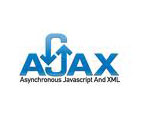
Ajax (shorthand for asynchronous JavaScript and XML) is a group of interrelated
web Development techniques used on the client-side to create interactive web applications.
With Ajax, web applications can retrieve data from the server asynchronously in
the background without interfering with the display and behavior of the existing
page. The use of Ajax techniques has led to an increase in interactive or dynamic
interfaces on web pages. Data is usually retrieved using the XMLHttpRequest object.
Despite the name, the use of XML is not actually required, nor do the requests need
to be asynchronous.
Like DHTML and LAMP, Ajax is not a technology in itself, but a group of technologies.
Ajax uses a combination of HTML and CSS to mark up and style information. The DOM
is accessed with JavaScript to dynamically display, and to allow the user to interact
with the information presented. JavaScript and the XMLHttpRequest object provide
a method for exchanging data asynchronously between browser and server to avoid
full page reloads.
In the 1990s, web browsers and web sites were based on static pages and each user
action required that the page be re-loaded from the server (or a new page loaded).
This could slow down user interaction considerably.
Asynchronous loading of content first became practical when Java applets were introduced
in the first version of the Java language in 1995. These allow compiled client-side
code to load data asynchronously from the web server after a web page is loaded.
In 1996, Internet Explorer introduced the IFrame element to HTML, which also enabled
asynchronous loading. In 1999, Microsoft created the XMLHTTP ActiveX control in
Internet Explorer 5, which was later adopted by Mozilla, Safari, Opera and other
browsers as the native XMLHttpRequest object. Microsoft has adopted the native XMLHttpRequest
model as of Internet Explorer 7, though the ActiveX version is still supported.
The utility of background HTTP requests to the server and asynchronous web technologies
remained fairly obscure until it started appearing in full scale online applications
such as Outlook Web Access,(2000) Oddpost (2002), and later, notably Google made
a wide deployment of Ajax with Gmail (2004) and Google Maps (2005).
The term "Ajax" was coined in 2005 by Jesse James Garrett. However, a patent application
covering this type of user interface was filed on September 3, 2003, thus predating
the term itself by two years. This application resulted in US Patent #7,523,401
being issued to Greg Aldridge of Kokomo, IN.
On April 5, 2006 the World Wide Web Consortium (W3C) released the first draft specification
for the object in an attempt to create an official web standard.
To inquire more about our Ajax Development,please
click here to contact us or email us at info@anitsolution.com